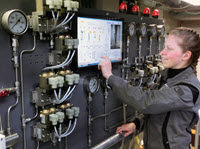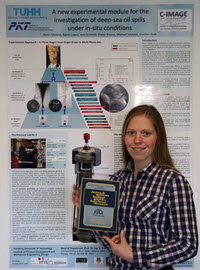
Karen operates a high-pressure test center. (Provided by Hamburg University of Technology)
The 2010 Deepwater Horizon incident highlighted new challenges and science gaps in our understanding of and ability to respond to deep-water oil releases. Of particular importance is how highly pressurized oil and gas behaves in a deep-sea environment. Karen Malone uses her engineering background to build high-pressure tanks that replicate deep-sea conditions in a laboratory so she can observe how pressure and temperature influence the behavior of oil droplets. Her findings will help responders and researchers predict the fate of oil and gas in the event of another deep-sea spill.
Karen is a Ph.D. student in the Hamburg University of Technology’s (TUHH) mechanical engineering program and a GoMRI Scholar with the Center for the Integrated Modeling and Analysis of Gulf Ecosystems II (C-IMAGE II).
Her Path
Karen grew up in Germany near the Wadden Sea, a North Sea intertidal zone where Wattwandern (walking several miles offshore or to islands at low tide) was a popular activity. However, after the 1998 Pallas cargo shipwreck caused one of Germany’s largest oil spills, she remembers being warned against the toxic oil slicks and finding dead birds along the shoreline. Twenty years later, Karen says it is still possible to find tar balls in the area’s beaches and tidelands. “When I heard about the 2010 Deepwater Horizon spill, those childhood memories sprang to my mind along with the perception that it would cause damage far beyond what I witnessed in the North Sea,” she said.
Karen completed a bachelor’s degree in engineering at TUHH and then entered the university’s mechanical engineering masters’ program, where she heard about their involvement with the C-IMAGE group. Although Karen’s mechanical engineering background did not include studies on ocean currents and oil-degrading bacteria, the consortium’s interdisciplinary aspects and exciting student research opportunities fascinated her. She completed her masters’ degree in 2013 and joined the C-IMAGE research team as a mechanical engineering Ph.D. student. “I was hooked by the relevancy of the research,” said Karen. “The project offered the unique possibility to utilize my engineering skills to contribute to society and nature conservation.”
Her Work

Karen mounts the experimental module for oil-and-gas jet investigations. (Provided by Hamburg University of Technology)
Karen designs and maintains the high-pressure tanks and experimental modules that her group uses for experiments, including a complete refit and reassembly of their lab. She investigates how temperature and water depth affect the behavior of oil and gas spilled from a sub-sea well. First, she releases a steady plume of oil into the water-filled high-pressure tanks to simulate conditions in the deep-sea environment during the spill. She then takes endoscopic measurements of the plume to assess the distribution of oil droplet size as droplets travel upward through the water column.
So far, Karen observed that oil stored without gaseous components (dead oil) behaved differently than the gas-saturated oil inside of a well (live oil), particularly in terms of droplet size distribution. Droplet size distribution depended strongly on the pressure drop near the wellhead and whether and how much oil was over-saturated with gas. Compared to larger droplets, smaller droplets rose to the sea surface more slowly, which increased the likelihood for microbial biodegradation as they travel up the water column. Slowly rising droplets are also easier for ocean currents to sweep up and transfer to other areas of the Gulf, increasing their area of impact. Furthermore, the gases that are present in live oil make droplets lighter, enhancing their buoyancy. Understanding these differences in behavior and droplet size distribution can help responders predict how oil will move and evolve through the water column.

A comparison of “dead” (left) and “live” (right) oil jets generated in the pressure lab. (Provided by Hamburg University of Technology)
Karen has also observed how pressure (water depth), temperature, and certain physicochemical oil properties may significantly influence the behavior of oil and droplet size distribution. While pressure changes barely affected dead oil, high-pressure conditions significantly affected the gases in live oil, causing oil droplets to rise more quickly. Conversely, Karen’s team also observed that methane gas often created a hydrate crust around gas bubbles that slowed their velocity. Colder temperatures at depth increased the viscosity of live oil, which produced slightly larger droplets that rise more slowly.
Though her research is ongoing, the data and knowledge that Karen’s team produce will contribute to the modeling efforts of the C-IMAGE near- and far-field groups to help predict the fate and behavior of spilled oil and gas. “The uncertainties in Deepwater Horizon response showed the large knowledge gap regarding the deep-sea nature of this spill,” said Karen. “[The behavioral differences between live oil and dead oil are] almost non-existent at sea-surface conditions. As previous experimental work in this area has only been done at surface conditions, these effects have not been observed before.”
Her Learning
Working with her advisor Dr. Dieter Krause, Karen learned how to manage a research project. She was responsible for the pressure labs and their maintenance, which taught her how to manage major test sites and organize experiments. She explained that their diverse research team introduced her to new and different methods of conducting research, “Working in an international and highly interdisciplinary collaboration has the great benefit of learning work habits from many different countries and cultures – and making good friends on the way.”
Her Future
Karen is focusing her energy on analyzing and processing her experimental data and plans to conduct additional experiments that could help answer some questions she has. She plans to graduate in early 2018 and pursue a research position where she can further develop her engineering and management skills and knowledge of multi-phase flow systems.
Praise for Karen

Karen’s poster received the James D. Watkins Award for Excellence in Research at the 2013 Gulf of Mexico Oil Spill and Ecosystem Science Conference in Mobile, Alabama. (Provided by Hamburg University of Technology)
Krause first noticed Karen’s potential in 2011, when she developed a model for variety allocation in product development during a student project. Her model is still widely used at TUHH and is well-recognized by the group’s industry partners. He explained that, although Karen joined C-IMAGE with no experience with oil spills and hydrodynamics, she adapted quickly and became an expert in her field.
Krause also praised Karen’s knowledge and experience with administrative and financial project management. “She independently manages and operates our high-pressure lab facilities. Her design and supervision of the lab’s refit resulted in an excellent research facility that offers unequalled opportunities for future research – and stayed well within budget.”
“Karen is a very dedicated and talented researcher,” he said. “I am certain her dissertation will reflect her excellent work within C-IMAGE, and I’m looking forward to her graduation next year.”
The GoMRI community embraces bright and dedicated students like Karen Malone and their important contributions. The GoMRI Scholars Program recognizes graduate students whose work focuses on GoMRI-funded projects and builds community for the next generation of ocean science professionals. Visit the C-IMAGE website to learn more about their work.
************
The Gulf of Mexico Research Initiative (GoMRI) is a 10-year independent research program established to study the effect, and the potential associated impact, of hydrocarbon releases on the environment and public health, as well as to develop improved spill mitigation, oil detection, characterization and remediation technologies. An independent and academic 20-member Research Board makes the funding and research direction decisions to ensure the intellectual quality, effectiveness and academic independence of the GoMRI research. All research data, findings and publications will be made publicly available. The program was established through a $500 million financial commitment from BP. For more information, visit http://gulfresearchinitiative.org/.
© Copyright 2010-2017 Gulf of Mexico Research Initiative (GoMRI) – All Rights Reserved. Redistribution is encouraged with acknowledgement to the Gulf of Mexico Research Initiative (GoMRI). Please credit images and/or videos as done in each article. Questions? Contact web-content editor Nilde “Maggie” Dannreuther, Northern Gulf Institute, Mississippi State University (maggied@ngi.msstate.edu).
